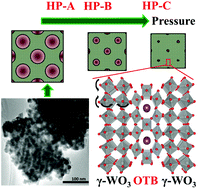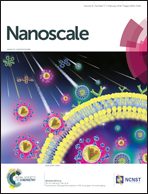Experimental and theoretical investigation of a mesoporous KxWO3 material having superior mechanical strength†
Abstract
Mesoporous materials with tailored properties hold great promise for energy harvesting and industrial applications. We have synthesized a novel tungsten bronze mesoporous material (KxWO3; x ∼ 0.07) having inverse FDU-12 type pore symmetry and a crystalline framework. In situ small angle X-ray scattering (SAXS) measurements of the mesoporous K0.07WO3 show persistence of a highly ordered meso-scale pore structure to high pressure conditions (∼18.5 GPa) and a material with remarkable mechanical strength despite having ∼35% porosity. Pressure dependent in situ SAXS measurements reveal a bulk modulus κ = 44 ± 4 GPa for the mesoporous KxWO3 which is comparable to the corresponding value for the bulk monoclinic WO3 (γ-WO3). Evidence from middle angle (MAXS) and wide angle X-ray scattering (WAXS), high-resolution transmission electron microscopy (HR-TEM) and Raman spectroscopy shows that the presence of potassium leads to the formation of a K-bearing orthorhombic tungsten bronze (OTB) phase within a monoclinic WO3 host structure. Our ab initio molecular dynamics calculations show that the formation of the OTB phase provides superior strength to the mesoporous K0.07WO3.


 Please wait while we load your content...
Please wait while we load your content...